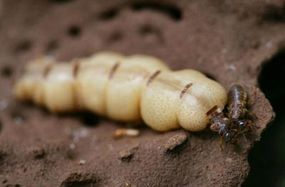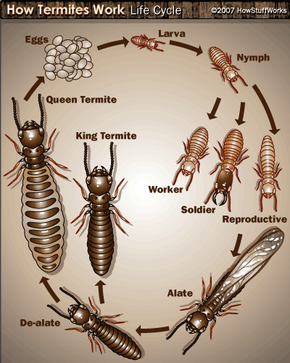Termite Reproduction
If you've ever seen live termite workers or looked at a picture of termites in their nest, you've probably gotten the impression that they look almost larval. They don't have hard exoskeletons like many insects do. Instead, they look soft and milky. Termites look larval because, in a lot of ways, they are larval. The only fully mature termites in an entire colony are the king and queen. Even the other reproductives are neotonic -- they are sexually mature but have larval qualities.
This perpetual larval state gives termites a lot of flexibility. Basically, all termites start as eggs, and all eggs are capable of developing into any caste. The eggs hatch into larvae, and through a series of molts, the larvae develop into workers. The workers can undergo a two-stage molt and become soldiers. Older termites can even undergo regressive molts and go back to an earlier stage.
Advertisement
When it's time for a colony to swarm, some workers molt into winged adults called alates, from the Latin word for "wing." The alates gather at an entrance to the colony and prepare to make their only flight, known as a nuptial flight. Their bodies harden and darken with exposure to the air. They begin to resemble winged ants.

Termites usually swarm in the spring when the air is very humid and still, often just after it's rained. Many species swarm simultaneously, even if their colonies are separated by long distances. Scientists are not sure how this happens, but they suspect that it helps improve genetic diversity by allowing termites from different colonies to mate. This is especially important because most of the alates do not live to bear young. Instead, they become food for birds, toads and other animals.
After a male and female alate form a pair, they land and break off their wings. At this point, they're called dealates. They look for shelter, typically in a small hole or depression that's near both soil and wood. They seal this nest with saliva, soil and their own waste. Then, they mate, and the new queen lays eggs.
The king and queen care for the first generation of the new colony on their own until they've raised enough workers to take over the job. Workers expand the nest, and the queen's abdomen enlarges so she can lay more eggs. It takes two to four years for the colony to mature, and then the cycle starts again with a new set of alates swarming to form new colonies.
In addition to laying eggs, the king and queen produce pheromones that help regulate life in the colony. These pheromones determine how many larvae become workers, soldiers and alates. If the king or queen dies, these pheromones disappear. Then, one of the secondary or tertiary reproductives becomes the new primary reproductive, sometimes after killing off the competition. Queens can live up to 25 years, while most workers live between two and five years.
Termite colonies can survive for a long time, and in some species, queens lay thousands of eggs every day. For these reasons, termite nests can be enormous. Next, we'll take a look at where termites live and how they build their homes.
